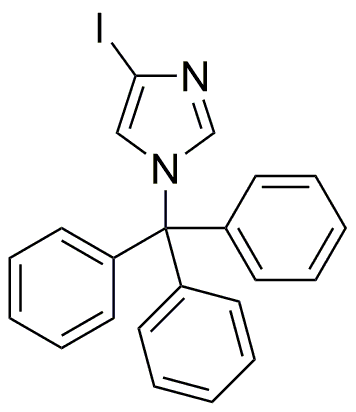4-Iodo-1-(triphenylmethyl)imidazole is widely utilized in research focused on:
- Pharmaceutical Development: This compound serves as a key intermediate in the synthesis of various pharmaceuticals, particularly those targeting specific biological pathways, enhancing drug efficacy.
- Chemical Synthesis: It is employed in organic synthesis as a versatile reagent, allowing chemists to create complex molecules efficiently, which is crucial in developing new materials.
- Biochemical Research: Researchers use this compound to study enzyme interactions and mechanisms, providing insights into biological processes and aiding in the discovery of new therapeutic targets.
- Material Science: The unique properties of this compound make it suitable for developing advanced materials, including polymers and coatings, which require specific chemical stability and reactivity.
- Analytical Chemistry: It is utilized in various analytical techniques, such as chromatography, to separate and identify compounds, ensuring high accuracy in research and quality control processes.
General Information
Properties
Safety and Regulations
Applications
4-Iodo-1-(triphenylmethyl)imidazole is widely utilized in research focused on:
- Pharmaceutical Development: This compound serves as a key intermediate in the synthesis of various pharmaceuticals, particularly those targeting specific biological pathways, enhancing drug efficacy.
- Chemical Synthesis: It is employed in organic synthesis as a versatile reagent, allowing chemists to create complex molecules efficiently, which is crucial in developing new materials.
- Biochemical Research: Researchers use this compound to study enzyme interactions and mechanisms, providing insights into biological processes and aiding in the discovery of new therapeutic targets.
- Material Science: The unique properties of this compound make it suitable for developing advanced materials, including polymers and coatings, which require specific chemical stability and reactivity.
- Analytical Chemistry: It is utilized in various analytical techniques, such as chromatography, to separate and identify compounds, ensuring high accuracy in research and quality control processes.
Documents
Safety Data Sheets (SDS)
The SDS provides comprehensive safety information on handling, storage, and disposal of the product.
Product Specification (PS)
The PS provides a comprehensive breakdown of the product’s properties, including chemical composition, physical state, purity, and storage requirements. It also details acceptable quality ranges and the product's intended applications.
Certificates of Analysis (COA)
Search for Certificates of Analysis (COA) by entering the products Lot Number. Lot and Batch Numbers can be found on a product’s label following the words ‘Lot’ or ‘Batch’.
Número de catálogo
Número de lote/lote
Certificates Of Origin (COO)
This COO confirms the country where the product was manufactured, and also details the materials and components used in it and whether it is derived from natural, synthetic, or other specific sources. This certificate may be required for customs, trade, and regulatory compliance.
Número de catálogo
Número de lote/lote
Safety Data Sheets (SDS)
The SDS provides comprehensive safety information on handling, storage, and disposal of the product.
DownloadProduct Specification (PS)
The PS provides a comprehensive breakdown of the product’s properties, including chemical composition, physical state, purity, and storage requirements. It also details acceptable quality ranges and the product's intended applications.
DownloadCertificates of Analysis (COA)
Search for Certificates of Analysis (COA) by entering the products Lot Number. Lot and Batch Numbers can be found on a product’s label following the words ‘Lot’ or ‘Batch’.
Número de catálogo
Número de lote/lote
Certificates Of Origin (COO)
This COO confirms the country where the product was manufactured, and also details the materials and components used in it and whether it is derived from natural, synthetic, or other specific sources. This certificate may be required for customs, trade, and regulatory compliance.


